Peter MALONE
Ennio
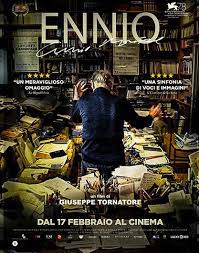
ENNIO
Italy, 2021, 156 minutes, Colour.
Directed by Giuseppe Tornatore.
Ennio (not any Oh! As Dragon Speech Registration prints out) but THE Ennio, the first Ennio who comes to mind, Italian maestro, Ennio Moricone. Practically everyone recognises the whistle of The Good, the Bad, and the Ugly, and the beats and flutes of The Mission. And, by the time of his death in 2020, aged 91, he was revered in music circles worldwide.
It is important to note, first, that this film has been directed by Giuseppe Tornatore for whom Moricone scored Cinema Paradiso and The Legend of 1900, being tribute himself enthusiastically but including an enormous range of talking heads, a great number of Italians, Americans like John Williams, Hans Zimmer, Quincy Jones and Bruce Springsteen, and many admiring directors, Clint Eastwood, Quentin Tarantino, Terrence Malick, Oliver Stone, Roland Joffe, Bruce Levenson, Dario Argento, Bernardo Bertolucci, Wong Kar Wai. No shortage of admirers. As we all are.
Perhaps best to say now that this is really a masterclass. And there is so much in it, that many will want to see it again. Yes, it contains the key phases in Moricone’s biography but it is also a portrait, so much of the material from interviews with Monicone himself, at different stages of his life and career, so that we spend a great deal of time with him. But, overall, it is a masterclass in musical composition, a great deal of theory and explanations (and challenges), a great amount of music to be heard on the score.
The first section is a must for students of composition. Film lovers will be have to be patient but will have an opportunity to understand the richness of the compositions, arrangements and orchestrations, choice of instruments (and sounds) which will enhance hearing the music they love.
Then the portrait moves to his film scores, Italian features and television of the first half of the 1960s, his wariness about working on film scores and their status in musical composition, the beginnings of his collaboration with Sergio Leone for all of his films for 20 years, from Fistful of Dollars to Once Upon a Time in America, then his work on so many spaghetti westerns, Italian gialli (pulp fictions) as well as for celebrated Italian directors, Dario Argento, Bernardo Bertolucci, Pier Paolo Pasolini, and then an increasingly surprising number of American films.
1986 and the Oscar audience was stunned when he did not win the Oscar for The Mission (and scenes of producer, Lord David Putnam, apologising), and finally a tribute with an Oscar for Life Achievement.
As he grew older, he worked on more classical styles and orchestrations and toured widely, live concerts as well as television concerts.
There is an interesting postscript for film lovers and buffs – his being persuaded, aged 85, by Quentin Tarantino to score The Hateful 8, and the accolade of winning the music Oscar in his own right.
While this is a review, it is also an encouragement to see (and hear) Ennio.
Velvet Queen, The/ La panthere des neiges (Snow Leopard)

THE VELVET QUEEN/ LA PANTHERE DES NEIGES (SNOW LEOPARD)
France, 2021, 92 minutes, Colour.
Vincent Munier, Sylvain Tesson.
Directed by Marie Amiguet, Vincent Munier.
While there are many wonderful documentaries on our television screens, our venturing into landscapes which we are never likely to visit in our lives, to see birds and animals which seem to us quite exotic, all in the darkened cinema with the big screen, can be an overwhelming experience.
Which is the case with The Velvet Queen.
Vincent Munier is a wildlife photographer and has built up a reputation over 20 years. And, he is also a cinematographer. Sylvain Tesson is a writer, a novelist. Together they go into remote Tibetan mountains on a quest, ultimately to observe the little seen Snow Leopard.
In terms of cinematography, the shots of the mountainous landscapes, the flat plains, the valleys, the ever-changing skies, the seasons and their moods, are beautiful, of course, but, at times, also breathtaking. But, we are not just invited to look. We are invited to accompany the two men, get to know them, see the landscapes and the animals from their perspective, knowing that in such difficult circumstances their principles of ignoring pain, ignoring time, trusting that what they wish for will happen, we will be amazed.
The two men are not in a hurry, they often sit and observe, they place the cameras, are delighted when they see a bear high on the cliffs, herds of antelope racing, stags in combat, eerie looking cats searching for prey, and so many of the local animals in their habitats, unfamiliar to us.
The two men are assisted by their assistant director and the director of the film, Marie Amiguet – but the latter two are completely unobtrusive. However, with such wonderful placing of the camera, use of lenses for extreme close-ups, distant takes, sometimes the camera high on cliffs looking down on the explorers, attention given solely to the two men and their quest, we feel we are there.
In the background are some of the Tibetan nomads and their flocks, a small community which welcomes the two men, genial meals, and a group of happy children, the Frenchman trying to communicate in the local language. But, after these engaging human episodes, it is back out into the mountains and, the final reward, captured on film for us, the Snow Leopard roaming the mountains, killing prey, feeding, but moving majestically in a world that very few human beings see.
Music score by Warren Ellis and songs by (and sung by) Nick Cave.
Lost Bullet/ Balle Perdue
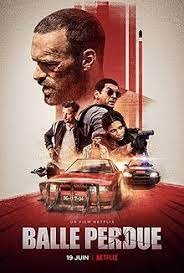
LOST BULLET/ BALLE PERDUE
France, 2020, 92 minutes, Colour.
Alban Lenoir, Nicolas Duvauchelle, Ramzy Bedia, Stefi Celma, Rod Paradot.
Directed by Guillaume Pierret.
If an audience is looking for a tough French gangster and police film, this 92 minute thriller, continual action, is a good choice.
The screenplay was written by its star, Alban Lenoir, who plays Lena, a small time crook who, with his brother, attempts a robbery to get some valuables in cash, drives his personally souped-up car through four walls, failing with the robbery, getting his brother to safety, his being arrested and going to prison.
The development of the plot concerns the chief of the drugs squad who is impressed by Lena’s talent with cars, gets in leave of absence from prison to work on strengthening the mobile fleet for the drug squad. And, in Highway pursuits of dealers and carriers, the cars are more than efficient.
However, what emerges, is that one of the main police officers on the squad is corrupt, working with his associate, skimming off money from the deals. Which builds up into dramatic confrontation between Lee no and the corrupt officer, a number of car chases, crashes.
And, as audience, we are caught up in all the action, some sympathy for Lee no and some characters, antipathy towards the corrupt police and their lack of scruple.
The corrupt police are shrewd, set up a Lee no as the fall guy, the authorities suspicious about him, pursuing him. And, then the film ends.
Two years later, the sequel was released, beginning with the very same sequences with which the first film ended. Which means then that Lena is still working on the cars, but has vengeance on the corrupt policeman’s assistant who has killed his brother in the previous film. There are some complications when the corrupt police still try to set up Lena, trapping, insinuating to the authorities that Lena is really a killer.
A lot of this sequel is taken up with work on the cars, a great number of car chases, issues of Spanish police and the border, suspicions within the police force of Lena, and is finally vindicating himself, but…
And the sequel and is there, ready for another film to take up at this moment.
- Police thriller? Brief, action-filled, characters?
- The settings, the French city, the coast, streets, shops, police precincts, prison, on the road, car chases? The musical score?
- The focus on Lino and Quentin, the need for money, the robbery, crashing through the four walls, Quentin allowed to go, Lena arrested, in jail? Is expertise?
- Charras, his team, working against drug dealers, vehicles, the need for reinforced vehicles, his approach to Lino, the interview with Moss? Lino, his work, Jeff, time passing, the success of the cars and reinforcements? The document for him to get out of jail, early release? The decision to visit Quentin, the consequences, the shooting of Charras, the later burning of his car, Areski and shooting, the bullet in the car?
- Lino, the fights, escape, contacting Julia, his relationship with her, her not believing him? Areski, Marco, the shooting of the men in the garage, Quentin’s escape?
- Areski, crooked police, control over a team, the drugs, the money? Doubledealing, the shooting of Charras? The discussions with Moss, hints, to mislead her? Insinuations about Julia? His reliance on Marco, brutal towards him, Marco not telling the truth about the hidden car? Setting up the roadblock, the crash through, his being exposed, going home, the money, his escape?
- Lino, his character, resourceful, strength, in fights, mechanical schools, the cars, meeting with Quentin, Marco and the shooting, tying up Marco, phoning Julia, persuading her, the meeting, with Quentin, going to the farm, Julia taken, interview with Moss, giving her the information?
- Quentin’s death, the rope and the leading to the car, uncovering it, putting on the grill, driving, the pursuit, crashing the car, the roadblock? The fire? Bringing the car in to the centre, Moss and Julia?
- The aftermath, Areski’s disappearance, Moss and her concessions, Julia and Lino, his injuries, through the windscreen?
- The sequel taking up immediately?
Lost Bullet 2/ Balle Perdue 2
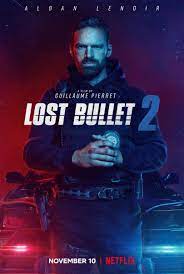
LOST BULLET 2/ BALLE PERDUE 2
France, 2022, 100 minutes, Colour.
Alban Linoir, Stefi Celma, Sebastien Lalanne, Nicolas Duvauchelle,
Directed by Guillaume Pierret.
If an audience is looking for a tough French gangster and police film, this 92 minute thriller,and its sequel continual action, are good choices.
The screenplay was written by its star, Alban Lenoir, who plays Lena, a small time crook who, with his brother, attempts a robbery to get some valuables in cash, drives his personally souped-up car through four walls, failing with the robbery, getting his brother to safety, his being arrested and going to prison.
The development of the plot concerns the chief of the drugs squad who is impressed by Lena’s talent with cars, gets in leave of absence from prison to work on strengthening the mobile fleet for the drug squad. And, in Highway pursuits of dealers and carriers, the cars are more than efficient.
However, what emerges, is that one of the main police officers on the squad is corrupt, working with his associate, skimming off money from the deals. Which builds up into dramatic confrontation between Lee no and the corrupt officer, a number of car chases, crashes.
And, as audience, we are caught up in all the action, some sympathy for Lee no and some characters, antipathy towards the corrupt police and their lack of scruple.
The corrupt police are shrewd, set up a Lee no as the fall guy, the authorities suspicious about him, pursuing him. And, then the film ends.
Two years later, the sequel was released, beginning with the very same sequences with which the first film ended. Which means then that Lena is still working on the cars, but has vengeance on the corrupt policeman’s assistant who has killed his brother in the previous film. There are some complications when the corrupt police still try to set up Lena, trapping, insinuating to the authorities that Lena is really a killer.
A lot of this sequel is taken up with work on the cars, a great number of car chases, issues of Spanish police and the border, suspicions within the police force of Lena, and is finally vindicating himself, but…
And the sequel and is there, ready for another film to take up at this moment.
- The immediate link with the first film, same sequences, leading to the consequences?
- The settings, the police precincts, the garage and the work with the cars? The new pursuits, the high-powered cars, crashes, and into Spain? The remote hideout? Musical score?
- Most of the film with the car chases, action sequences, effects, drama?
- Lino, the immediate aftermath of the first film, the relationship with Julia, with Moss, going to meet Stella, the animosity towards Areski, the relationship with her? Julia’s reaction? A year passing, Lino and his work, yet wanting vengeance on Marco for the death of Quentin?
- The phone call, allegedly from his mother, the new team, to capture Lino and put blame on him? Lino going to the rendezvous, finding Marco, the attack, the fight with the team, getting Marco away? Moss and the phone calls, Julia and the phone calls, his bringing Marco back to the headquarters and marching him in?
- Lino not knowing the truth, Moss and her plan, witness protection for Marco, to get to the boss and evidence against him? Lino wanting him to go to prison for the death of Quentin?
- The fight in the headquarters, the new gang arriving, demanding Marco? The even more elaborate fights, Lino taking Marco, in the boot of the car? The intention to take Marco into Spain? The contact with Alvaro?
- Julia, the pursuit, the driving, her team? The powers that be setting up the roadblocks?
- The know, his driving, his including the pursuit, phoning Alvaro, his arriving with the van, Marco in the van, their going towards the checkpoint, the authorities getting the news, setting up the alternate roadblock?
- Lino, misleading the pursuers, Julia pursuing, the crashes, Marco gone?
- Alvaro, the cover of the van, making for Spain, the roadblock, the shooting, the injured driver? Marco and his fear? The crash, Marco escaping, Alvaro and the pursuit?
- Julia, taking Lino, her team handcuffing him? In the car, the crash, his finding Marco, dragging him to the restaurant, across the border into Spain, the girl ringing the police, Marco and his attack on Lino, stabbing him? Julia arriving, Marco holding the woman as hostage, Julia’s tactic, the gun, shooting Marco? Lino, his getting the gun, shooting Marco?
- Julia, the confrontation with Moss, no more lies? Lino to be blamed for Marco’s death?
- The postscript, a risky going to the car yard, the worker with his box from Lino’s car, the metal, the setting up of the sequel?
9 Bullets
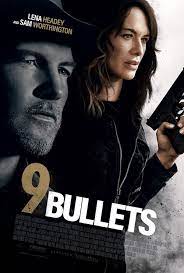
9 BULLETS
US, 2022, 97 minutes, Colour.
Lena Headey, Sam Worthington, Dean Scott Vazquez, Cam Gigandet, LaLa Anthony, Barbara Hershey, Colleen Camp.
Directed by Gigide Gaston.
The central character, Gypsy, says it would take nine bullets to end her life.
This is a chase thriller focusing on Gypsy, game of thrones Lena Headey, who is caught up with a sleazy millionaire gangster, Sam Worthington, pursued by his thugs, witnessing the assassination of a young boy’s parents, finding him and wanting to take him to safety to his Rabbi uncle.
Lena Headey is a strong screen presence – with quite a complicated character, starting off well, intelligent, going to Princeton, raped by a Professor, pregnant, disowned by her father, drinking, her life collapsing, becoming a stripper, becoming involved with the criminal who rescues her. With the memories of her dead child, revealed later in the film, she is very wary of taking up with the little boy, a precocious child, Dean Scott Vazquez, who is handy with computers and knows a lot about bitcoin as well as the financial dealings of his father who had robbed the criminal.
The film moves across several American states from Utah to Montana, to the mansion owned by the criminal, with his latest girlfriend who becomes viciously jealous. Gypsy tries to exercise seductive power on the criminal in order to save the boy.
The various steps along the way, getting some kind of refuge, stealing cars, especially a tangle with another stripper, taking refuge with a friend, played by Barbara Hershey.
There are some shootouts, Gypsy wounded, but delivering the boy to his uncle.
This is something of an equivalent straight-to-video action film, but not particularly well received, especially by the comments on the IMDb blog.
Millie Lies Low

MILLIE LIES LOW
New Zealand, 2021, 100 minutes, Colour.
Ana Scotney, Jillian Nguyen, Chris Alosio, Sam Cotton, Karen O'Leary, Cohen Holloway Erin Banks, Rachel House.
Directed by Michelle Savill.
As it emerges, the important word in the title is, in fact, lies. The scenario begins with a huge lie which has enormous consequences, whopper consequences – and more and more lies.
The Millie of the title, an architecture student in Wellington, spends most of the action of the film lying low in Wellington when she should be in New York City. But, in terms of the audience spending 100 minutes with her, she is centre screen, in every sequence, not lying low at all with the audience.
Millie is a young twentysomething. Her friends are twentysomethings. And, with the characters and style of the film, the target audience is twentysomethings, with an emphasis on female twentysomethings invited to identify with Millie, her problems, her lies, her lying low, her unwillingness to come to terms with herself and her past, her eventually having to face facts, willingly and unwillingly.
Which makes the film sound rather serious. And, in its underlying themes, it is. However, it is all treated by the writer, Michelle Savill, with more than a comic touch. Millie gets herself into all kinds of bizarre situations, pretending she is not in Wellington, avoiding all her friends, experiencing great difficulties in finding somewhere to stay, a bizarre encounter with one of her lecturers, sending texts and photos contrived as if she were happily in New York.
As we meet her, initially, she is in the plane, has a panic attack and demands to be let off the plane. Which has all kinds of consequences, insurance and no refunds, wanting to buy another ticket, the fact that she has sold her car to her friend, Caroline, and needs the cash to pay for another ticket, complications with the bank loan… And she won’t admit to having the panic attack.
While the story has some appeal for the twentysomethings, 30 something audiences will be wanting to forget any similar kinds of experiences in their lives, 40 somethings will feel rather exasperated, perhaps, and 50 somethings will probably be thinking ill of Millie, especially their thinking that this could be their daughter or granddaughter!
In the latter part of the film, we actually meet Millie’s mother, played by the always-welcome New Zealand character actress, Rachel House. Some possibilities for Millie coming to terms with what she has done and the consequences of her lies. Audiences will find the sequence of her being unmasked amusing, bizarrely amusing.
Ana Scotney as Millie, once we have accepted the panic attack and the consequences, offers quite a consistent performance as Millie lying and as Millie lying low.
Splice Here - a Projected Journey
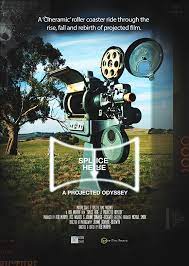
SPLICE HERE – A PROJECTED JOURNEY
Australia, 2022, 118 minutes, Colour.
Directed by Rob Murphy.
A wonderfully-indulgent two hours of screen-watching. Gratitude to Rob Murphy for persevering with this “projected journey” – he is a genial host, director, editor, cinematographer.
And who will enjoy this indulgence?
Film lovers for a start, those who love to watch movies even if they don’t know all that much of cinema history detail. It doesn’t matter. In the past, we enjoyed going to the pictures. Now we enjoy watching the movies – best in the darkened cinema, good on TV although smaller, and okay on computer screens – within our grasp.
And, of course, even more so, the film buffs who will relish delving into the past, ticking off the movies they love, wanting more.
And there are of those who love pre-history and from the 2020s vantage point and, the cinema prehistory era and to an end as the 21st century began! Digital!! But, relief, the wonder of restoration of film is underway despite the nitrate copies combusting and companies burning unwanted stock (with a visual note here that the great fire in Atlanta in Gone with the Wind was unwanted and unblocked stock coming up in flame and smoke). The hoarders and collectors are banding together now in order to restore as much as possible that which was lost.
And the film technos, with their knowledge of lenses, projectors, sound engineering, colour and the marvels of the 1950s showing us the advent of Cinerama, drawing us into the wide film (instead of throwing things at us as in 3-D). Cinerama was too difficult demanding to project, three projectors in harmony, and those projectors disappearing into storage, hoarders sheds, but now making a reappearance.
As Rob Murphy chronicles all of this, tracking down contacts, making discoveries, visits to the US – and his collecting interviews from all kinds of experts in Australia and elsewhere, the communities of now veteran and unneeded projectionists, the memories in the details of projecting. And now Digital, which is not necessarily a permanent preserver of films but is increasing the knowledge and technologies of preservation. And Douglas Trumbull (memories of 2001, Brainstorm) interviewed and continually experimenting with technology and discoveries.
The culmination of Rob Murphy’s storytelling is the quest to equip the Sun Cinema in Yarraville in 2014 to screen Quentin Tarantino is The Hateful 8, all those involved, for projecting perfection, the arrival of the lens, 70 mm, Tarantino learning of the efforts and coming to Yarraville to welcome the audience and share the joy with those at the Sun.
But the title! Not a great deal of splicing shown. However, this reviewer offers a reminiscence from the good old days. He projected 16mm prints at his New South Wales boarding school, 1953-1956, aged 13 to 17, only one projector. And splicing? Sometimes, especially for “censorship” purposes, particularly with Greer Garson in Julia Misbehaves (Greer Garson of all actresses misbehaving!). But we could cut the suspect sequences, splice them back together neatly and perfectly and MGM were none the wiser. An almost 70 years old confession.
But for all of us who love film and the younger generations who do not know this prehistory and the wonderful dinosaur projectors, please, watch, enjoy, learn.
Episcopal MSC
Episcopal MSC

You might enjoy seeing a list of our members of the Hierarchy (starting with a photo of Cardinal Ribat recently at Via Asmara).
And check the list of final prelates.
Living Bishops (1 Cardinal, 4 Archbishops, 16 Bishops)
Other Present Prelates (2)
|
Fr. Ariel Galido, M.S.C. (47), Prefect Apostolic of Marshall Islands (Marshall Islands) |
|
Fr. Stephen Hackett, M.S.C. (63), General Secretary of Australian Catholic Bishops Conference |
Heart of Life Centre Graduations – a selected photo gallery Photos by Trieu Nguyen and some by Peter Malone
Heart of Life Centre Graduations – a selected photo gallery

Our two Siloam graduates, Spiritual Direction, Khoi and Chung
Photos by Trieu Nguyen and some by Peter Malone

Chris McPhee presiding, St Paschal's chapel, Box Hill

The full-time group with supervisors Jeff Hood and Peter Hay. Chung graduating.

Part-time, 2021-2022, with supervisors Marlene McGrath and Carole Carmody. Khoi graduating

All graduates including Spiritual Leaders

Some dance during the Liturgy of the Word

The MSC presence

The full-time group with Peter Malone, lecturer and tutor, the MSC on the staff

It was Chris McPhee's birthday acknowledged after the ceremony
Martin Wilson and his booklet Early Days at Peppiminarti Homeland Village. Not long before he died, last month, Martin Wilson published a memoir of the centre at Peppiminarti in the Northern Territory. The Chevalier Institute at Kensington issued it
Martin Wilson and his booklet Early Days at Peppiminarti Homeland Village.

Not long before he died, last month, Martin Wilson published a memoir of the centre at Peppiminarti in the Northern Territory. The Chevalier Institute at Kensington issued it.

Martin worked for many years in the NT, visiting Peppiminarti many times. He established the Nelen Yubu centre and the magazine, as well as publishing a number of books.

Martin has written a memoir text. And there are 9 pages. The bulk of the book is 40 pages of photos, two per page. Then an epilogue.

Martin was 92 when he died.

And a special visitor



